
The Palazzo Venturi, once known as Palazzo Doni is a Renaissance-style palace located in central Florence, region of Tuscany, Italy. It located on via de' Banchi 2. The palace differs from the Palazzo Venturi Ginori on Via della Scala.

The Palazzo Venturi, once known as Palazzo Doni is a Renaissance-style palace located in central Florence, region of Tuscany, Italy. It located on via de' Banchi 2. The palace differs from the Palazzo Venturi Ginori on Via della Scala.
The site was once the home of some houses belonging to the Bischeri family. In 1599, the Doni Family, who had acquired the site, commissioned the present structure from either Bernardo Buontalenti or Gherardo Silvani. The palace was inherited by the Bourbon del Monte, who sold it in 1667 to Cosimo Venturi, whose family also owned also the nearby palace on via de' Banchi 4. The Venturi family commissioned much of the interior decoration. The palace remained with the Venturi family until 1850, when it was sold to prince Ercole dei Pio of the Savoy Family. The palace is presently occupied by an inn.
The entrance to the palace still houses the heraldic shield of the Venturi, with three golden rocks on a blue background below the sign of the Anjou. The first floor has ceilings frescoed with grotteschi by Bernardino Poccetti.

The Palazzo Pitti, in English sometimes called the Pitti Palace, is a vast, mainly Renaissance, palace in Florence, Italy. It is situated on the south side of the River Arno, a short distance from the Ponte Vecchio. The core of the present palazzo dates from 1458 and was originally the town residence of Luca Pitti, an ambitious Florentine banker.

The Palazzo Ducale di Mantova is a group of buildings in Mantua, Lombardy, northern Italy, built between the 14th and the 17th century mainly by the noble family of Gonzaga as their royal residence in the capital of their Duchy. The buildings are connected by corridors and galleries and are enriched by inner courts and wide gardens. The complex includes some 500 rooms and occupies an area of c. 34,000 m2, which make it the sixth largest palace in Europe after the palaces of the Vatican, the Louvre Palace, the Palace of Versailles, the Royal Palace of Caserta and the Castle of Fontainebleau. It has more than 500 rooms and contains seven gardens and eight courtyards. Although most famous for Mantegna's frescos in the Camera degli Sposi, they have many other very significant architectural and painted elements.
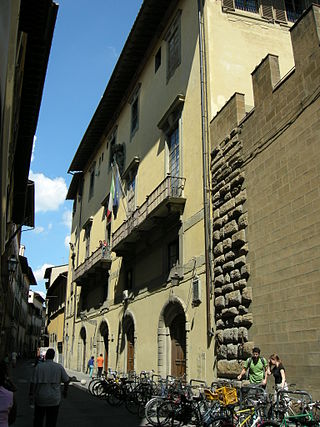
The Biblioteca Riccardiana is an Italian public library under the aegis of the Ministry of Culture, located inside the Palazzo Medici Riccardi at 10 Via de’ Ginori in Florence, in the neighborhood comprising the Mercato Centrale and the Basilica di San Lorenzo. Its main feature is preserving books collected by members of the Riccardi family and making them available in the very same rooms that were originally dedicated to that purpose. So, still today the library boasts the magnificent bookshelves, neatly carved and gilded, that create the atmosphere of a late-seventeenth-century patrician library, whose main features have all been kept intact.
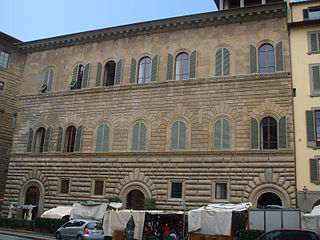
Palazzo Gondi is a palace in Florence, Italy, located a block from Piazza della Signoria. It was built in 1490 under design by Giuliano da Sangallo, who was inspired by other major works of stately buildings in the city, such as Palazzo Medici and Palazzo Strozzi. Among the elements borrowed from these earlier works are the cube-shape set around a central courtyard, the ashlar sloping on each of three floors, and the arched windows.

Palazzo Antinori is a Renaissance palace located at the north end of Via de' Tornabuoni, where it makes an odd corner with Via dei Pecori, Via del Trebbio, and converts into Via dei Rondinelli, in Florence, Italy.

Carli Palace is a Neoclassical style palace located in Via Roma in the city center of Verona.

The Palazzo Piccolomini, also known as the Palazzo Todeschini Piccolomini is a Renaissance-style palace in the city of Siena, region of Tuscany, Italy. It is located on the Banchi di Sotto, at the corner with Via Rinaldini; uphill and west of the church of San Martino, the Loggia del Papa, and the Palazzo delle Papesse, which also built by a Piccolomini family member.

The Palazzo Minerbetti is an urban palace building located on Via de' Tornabuoni #3 at the corner with Via del Parione, which edges into the Piazza Santa Trinita, Florence, in central Florence, Italy.
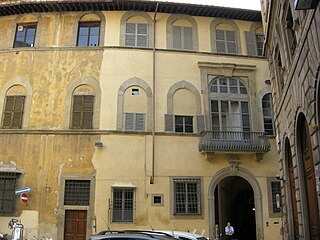
The Palazzo or Casa Martelli was a residential palace, and since 2009, a civic museum displaying in situ the remains of the original family's valuable art collection, as well as its frescoed rooms. The palace is located on Via Ferdinando Zannetti 8 near the corner with Via Cerretani in central Florence, region of Tuscany, Italy.
The Palazzo Tempi, also known as Palazzo Vettori or Bargagli Petrucci, is a palace located along the Arno river at the narrow Piazza Santa Maria Soprarno 1, corner with Via de' Bardi and Costa dei Magnoli in the Oltrarno section of Florence, Tuscany, Italy. The palace is across the river from the Galleria of the Uffizi, and a block east of the Ponte Vecchio. The Via de' Bardi originates in an arch under the building.
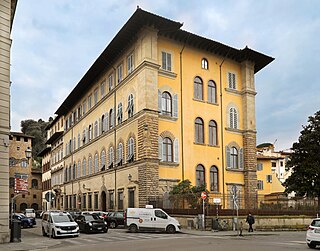
The Palazzo Torrigiani Del Nero is a Renaissance-style palace located at Piazza de' Mozzi 5, down the street where the Ponte alle Grazie enters the Oltrarno in Florence, Tuscany, Italy. Another Palazzo Torrigiani stands alongside, the smaller Palazzo Nasi. Both palaces also once belonged to the Nasi.

The Palazzo Angelo Giovanni Spinola is a palace located in Via Garibaldi, in the historical center of Genoa, in Northwestern Italy. It was one of the 163 Palazzi dei Rolli of Genoa, the selected private residences where the notable guests of the Republic of Genoa were hosted during State visits. On 13 luglio del 2006 it was included in the list of 42 palaces which now form the UNESCO World Heritage Site Genoa: Le Strade Nuove and the system of the Palazzi dei Rolli. Now owned by a bank, it is possible to visit the areas open to the public.

The Palazzo Doria or Palazzo Andrea e Gio. Batta Spinola is a palace located in Via Garibaldi, in the historical center of Genoa, in Northwestern Italy. It was one of the 163 Palazzi dei Rolli of Genoa, the selected private residences where the notable guests of the Republic of Genoa were hosted during State visits. On 13 luglio del 2006 it was included in the list of 42 palaces which now form the UNESCO World Heritage Site Genoa: Le Strade Nuove and the system of the Palazzi dei Rolli.

The Palazzo Spinola di Pellicceria, also known as Palazzo Francesco Grimaldi, is a palace located in piazza di Pellicceria in the historical center of Genoa, Northwestern Italy. The palace was one of the 163 Palazzi dei Rolli of Genoa, the selected private residences where the notable guests of the Republic of Genoa were hosted during State visits. On 13 luglio del 2006 it was added to the list of 42 palaces which now form the UNESCO World Heritage Site Genoa: Le Strade Nuove and the system of the Palazzi dei Rolli. It is currently owned by the Ministry of Cultural Heritage and Activities and Tourism and houses the National Gallery of Art in Palazzo Spinola.
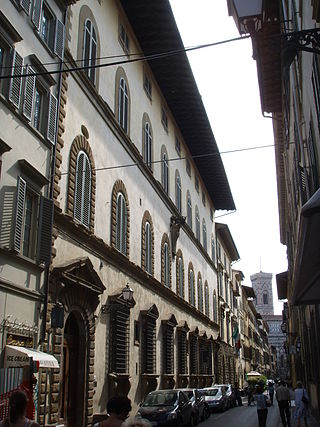
The Palazzo Gerini is a Renaissance-style palace located on via Ricasoli 42 in Florence, Italy.

Palazzo Sacchetti is a palazzo in Rome, important for historical and artistic reasons.

The Palazzo Lercari-Parodi or Palazzo Franco Lercari is a building located at number 3, Via Garibaldi in the historical centre of Genoa, included on 13 July 2006 in the list of the 42 palaces inscribed in the Rolli di Genova that became World Heritage by UNESCO on that date.

The palazzo Baldassarre Lomellini also known as palazzo di Cristoforo Spinola or palazzo Campanella is a building located in via Garibaldi at number 12 in the historical centre of Genoa, included on 13 July 2006 in the list of the 42 palaces inscribed in the Rolli di Genova that became World Heritage by UNESCO on that date.
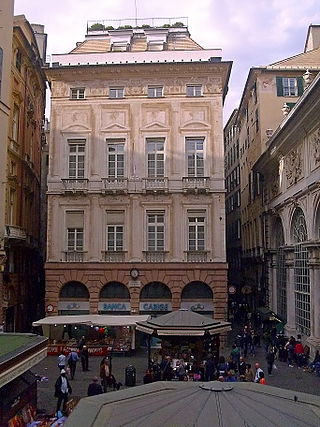
The Palazzo Ambrogio Di Negro is a building located in Via San Luca at number 2 in the area of the Mercato di Banchi in the historic centre of Genoa, included on 13 July 2006 in the list of the 42 palaces enrolled in the Rolli di Genova that became World Heritage by UNESCO on that date. It preserves an important Mannerist painting cycle inside. In front of the palace is the Loggia dei Mercanti (Genoa) and the Church of San Pietro in Banchi.

Palazzo Visconti di Grazzano, also known as Palazzo Visconti di Modrone or Palazzo Bolagnos, is a historical palace located in the centre of Milan, in Via Cino del Duca no. 8.